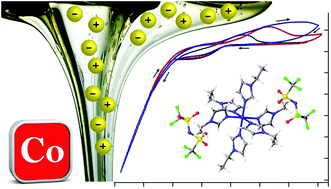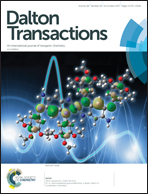Cobalt(ii) containing liquid metal salts for electrodeposition of cobalt and electrochemical nanoparticle formation†
Abstract
Cobalt(II)-containing liquid metal salts (LMS) with N-alkylimidazole ligands and bis(trifluoromethanesulfonyl)imide (bistriflimide, Tf2N−) or methanesulfonate (mesylate, OMs−) anions were synthesized and characterized. The chain length of the alkyl side chain on the imidazole ligand was varied. All compounds were characterized using CHN analysis, DSC and FTIR measurements. Single-crystal X-ray diffraction measurements were performed on six of the compounds for which single crystals of good quality could be obtained. All cobalt(II) centers are six-coordinate with the N-alkylimidazole ligands in an octahedral configuration and the anions are non-coordinating. The same coordination environment was observed by EXAFS measurements on cobalt(II) liquid metal salts in the liquid state. The electrochemical properties of the compounds with the lowest melting temperatures were investigated using cyclic voltammetry. It was found that part of the current was consumed in the electrodeposition of cobalt, whereas the other part of the current was consumed in the electrochemical formation of cobalt(0) nanoparticles.



 Please wait while we load your content...
Please wait while we load your content...